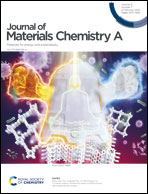Conjugated polyelectrolytes for stable perovskite solar cells based on methylammonium lead triiodide†
Abstract
Despite the outstanding role of conjugated polyelectrolytes in organic solar cells, the use of conjugated polyelectrolytes in perovskite solar cells (PSCs) has rarely been reported due to instability issues of the material itself under operating conditions. Herein, an efficient and stable inverted perovskite solar cell (p–i–n) was fabricated by introducing an amine-containing carbazole-based conjugated polyelectrolyte (CzNBr) with a simple and room temperature solution process as a cathode buffer layer (CBL) at the underlying layer of a metal electrode in PSCs. Promisingly, this approach allows not only modification of the work function of the metal electrode, yielding improved charge extraction properties, but also detainment of the migrating ionic defects of the perovskite layer induced by the metal electrode, resulting in robust stable PSCs. Ultimately, it exhibits a significant enhancement of both the efficiency (20.28%) and stability of PSCs based on methylammonium lead triiodide (MAPbI3); nonencapsulated PSCs maintained 80% of their initial efficiency (T80) under continuous heating at 85 °C for 1000 hours and 50 cycles of thermal cycling tests (from −25 to 85 °C). The excellent charge extraction and detainment of ionic defects with the CzNBr layer enable the demonstration of highly stable and efficient PSCs to prove the huge potential of this new type of CBL in applications. Furthermore, our results open up new possibilities for CPEs in PSCs in terms of their performance to demonstrate easily processed highly efficient and stable PSCs.



 Please wait while we load your content...
Please wait while we load your content...